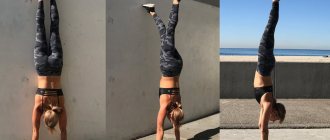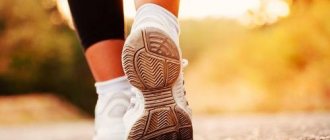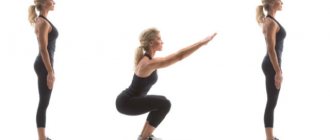Many experts around the world have long recognized health-improving walking as a universal type of exercise for our body.
This sport can be practiced by people of any age, even children. Depending on physiological indicators, there are certain conditions for each group. Dr. Shishonin talks about how to walk correctly so as not to harm your joints. Interesting Facts.
Scientists have proven that regular walking reduces the risk of breast cancer by 30%, reduces the intensity and frequency of hot flashes during menopause, and relieves menstrual pain. It has been established that the average inhabitant of our planet walks about 402,000 km throughout his life.
If you walk one leg at a time, what can it lead to?
You shouldn’t think that walking correctly is necessary solely for beauty. An incorrect gait is the path to back diseases, joint diseases, and headaches.
Walking is a complex process that is coordinated by the human nervous system. While walking, muscles tense and relax not in a chaotic manner, but in a certain sequence. The movement of the right leg relaxes the muscles that are responsible for the movement of the left arm, and vice versa. If the right muscles do not relax in time while walking, imbalance occurs and tension occurs. In addition, prolonged improper walking can provoke pain and even contribute to the shortening of certain muscle groups.
Everyone knows that the nerve pathways in our body are crossed, that is, the right hemisphere controls the left side, and the left hemisphere controls the right. When the work of both hemispheres is balanced, a person feels good. Improper walking disrupts the functioning of the brain hemispheres , which can result in physical exhaustion, apathy, bad mood and other negative consequences from the nervous system.
If we talk specifically about walking one leg at a time, not only is it very unaesthetic, but it is also dangerous due to falling and getting injured.
Correct and incorrect gait
With the correct gait, the spine is straight, the head, shoulders and pelvis are almost motionless, the arms move in rhythm with the walk. The body weight moves smoothly from foot to foot, the step width does not exceed two foot lengths. With each step, some muscles relax, others contract, alternating. In total, more than 200 muscles are involved in walking.
If the normal walking mechanism is disrupted, the desired muscle does not turn on in time, and its antagonist does not relax. Muscle imbalance occurs. As a result, muscle spasms, tension, pain appear, some muscles shorten and other muscles weaken. You can try to correct this imbalance with massages, a chiropractor or an osteopath, but the problem will quickly return. After all, after the session, you will again reproduce the same motor errors that brought you to a specialist.
Where to start changing your gait?
If abnormal gait is not the result of some acute illness, you need to start correcting it as soon as possible.
Important! If an incorrect gait is associated with pathologies occurring in the body, the first step is to eliminate the provoking factor, and only then focus on the beauty of the gait.
As already mentioned, changing your gait is a long-term process that will require willpower and constant control of your movements so that they become a habit. Correct body position will be uncomfortable at first , especially for those who are used to slouching or clubfooting. There is a whole set of exercises that will allow you to walk more elegantly and beautifully.
The basis of a beautiful gait is posture, so the first thing you need to do is straighten your back, raise your shoulders high, pull them back and lower them. This is the correct posture that must be constantly maintained. At the same time, the chest is relaxed, the stomach is slightly retracted, and the chin is raised. The muscles of the thighs and buttocks are tense, the feet are parallel to each other.
When walking, you need to pay attention to what moves forward first - the body or the legs? If the body moves forward first, such a gait cannot be called elegant. The correct gait is that the foot comes first, and then the body follows.
It’s not nice to put your feet too wide, but you shouldn’t mince either. The length of your step should be equal to the length of your foot. Of course, you don’t need to measure your feet in cm, walk “by eye.”
Important! The figure-of-eight gait is attractive only on the catwalk; in everyday life, from the outside it seems funny and absurd.
You should not swing your arms when moving, and you should not put your hands in your pockets. You need to move your hands according to the rhythm of your step, and you also need to make sure that your chin does not lift up too high.
The benefits of healthy walking
Healthy walking is recommended for absolutely all categories of people, regardless of their gender, age, physiological characteristics and health status. In the process of walking, energy metabolism is intensified, the body's immune resistance is strengthened, and the work of muscles, internal organs, and the cardiovascular system is activated. In addition, healthy walking helps to cope with extra pounds.
With daily walking you can achieve the following effects:
- improve overall well-being;
- strengthen the heart muscle;
- increase endurance;
- strengthen the muscle frame;
- reduce intraocular pressure;
- prevent the development of thromboembolism, heart attack and stroke;
- reduce the risk of developing cancer;
- improve mood;
- optimize brain function;
- reduce blood cholesterol levels;
- normalize the functioning of the digestive tract;
- reduce the risk of developing type II diabetes mellitus;
- normalize sleep;
- relieve feelings of helplessness;
- increase life expectancy;
- activate the immune system;
- increase lung capacity and depth of breathing;
- eliminate stressful phenomena;
- strengthen the musculoskeletal system.
What exercises are there for proper gait?
As is clear from the above, if you learn to maintain correct posture, your gait will immediately become more aesthetically pleasing. In order for correct posture to become a habit, it is recommended to perform the following exercises for the back:
- Lying on the floor, spread your arms to the sides. Straining your neck muscles, raise your head and pull your toes towards you. Stay in this position for 10 seconds.
- Sitting on a chair, place your hands behind your head and bend over. Hold for 5 seconds.
- Sitting on your knees, move your arms back and grab your ankles with your fingers. Slowly lean forward, touch your forehead to the floor and stay in this position for 20 seconds.
- Standing, clasp your hands behind your back. Alternately tense and relax your arm muscles.
- On your knees, hold onto the chair with your hands and bend your back. Stay in this position for 10 seconds.
- Lying on your stomach with your arms extended along your body, raise your head, arms and legs a few cm from the floor. Stay in this position for 10 seconds.
- Lying on your back, understand your body without lifting your legs off the floor. Use only your back muscles.
- Lying on your stomach, grab your ankles with your hands and bend as far as possible. Hold for 10 seconds.
If you perform these exercises 5-10 times daily, the training will soon bear fruit - your posture will improve, and therefore your gait will change for the better .
Checking the fast walking method
One day I returned my car for repair and went to the metro. The car service center was 2 km from the metro, and on the way a young, long-legged guy caught up with me. He was a sporty guy and a head taller than me, and he was in a hurry. I walked at my usual fast pace. But he's even faster. Not only are his legs longer, but he moves them more often.
Something struck me here. Will I really not catch up?
I must say that less than a year ago I underwent surgery on the hip joint. More precisely, my joint was replaced with an artificial one. That's why my leg still hurt.
But I decided to try my own method. And then the incredible happened. Instead of increasing the distance between us, it began to quickly shrink. Moreover, I found it very funny. Because I walked at a slower pace, not in a hurry, but I easily overtook him. I felt that he was going at his maximum speed. And I could even add a little. In general, at the metro I overtook him by 30 meters.
In the end, I realized that the method really works. In addition, it develops the calf muscles.
Walk faster and exercise at the same time. I wish you success.
Our tips and recommendations
Once correct posture has become habitual for you, you can begin exercises for correct gait:
- Place a book or a small pillow on your head and try to walk around the room with it, sit on the sofa, stand on one leg. Were you able to hold it? This means you have the correct position of your neck and head. If it doesn’t work out, practice.
- Walk in place without lifting your toes from the floor - this exercise develops your leg muscles well, which is very important for a beautiful gait.
- Imagine that your foot has a semicircular shape. Roll from heel to toe and back.
Install a floor-length mirror in the room, and walk for half an hour a day, observing your posture and the placement of your feet.
If you're ready to put on your heels and walk down the street in style, don't forget:
- Place your feet with your toes apart, otherwise your gait will be clubfoot.
- When placing the foot on the ground, the heel should touch it first (even if for a moment), and only then the entire foot.
- When transferring the center of gravity to the leg, it must be completely straight, otherwise walking “half-bent” cannot be avoided.
- To walk beautifully in heels, your legs must be strong and well-trained, so dance or join the gym.
By gait you can judge a person’s character and his state of mind at the moment. Stress, lack of self-confidence, and fear of appearing funny provoke slouching. Therefore, in order to walk correctly, you also need to think correctly . Remember the heroine of the film “The Most Charming and Attractive”? Convince yourself of your attractiveness, and your gait will instantly improve.
Walking up the stairs
Walking up the stairs of a high-rise building is the easiest way to improve your well-being. Where to begin? Because one prefers going up and down flights of stairs to entering an elevator.
The benefits of walking up the stairs are the development and strengthening of leg muscles, stabilization of blood pressure, and weight loss. Climbing stairs burns several times more calories than running on a flat surface. The lesson gives a positive effect if it lasts at least 20-35 minutes. But the time frame for reaching this time is individual for everyone.
The benefits of walking are not associated with a specially allocated time. All you need is this:
- prohibit yourself from using the elevator,
- ignore the escalator if there are stairs nearby;
- refuse transport to and from work at acceptable distances.
"Safety Tips" to Consider When Walking
- It is better to walk early in the morning so that the body has enough energy and blood circulation increases. Moreover, walking in the morning is also good for the body due to the absorption of vitamin D from the first rays of the sun.
- The faster you walk, the more calories you burn.
- Don't walk after eating. Some say that walking immediately after eating can improve digestion. However, this is a false concept as walking immediately after eating affects the digestive juices, thereby preventing the breakdown of food.
- It is not recommended to drink large amounts of water before walking, as this can disrupt the processes in the respiratory system.
- But it’s still worth drinking before training, as well as after it. Freshly squeezed juices will help revive metabolic processes, thereby helping the body burn more calories.
Have you ever thought about walking from a weight loss perspective? Always remember that as soon as you stop physical activity, all the results achieved disappear. So it’s time to put on some nice sneakers and step into a new and “slim” life.
Be healthy!
FacebookTwitterPinterestEmailWhatsAppVKontakte
How many calories can you burn if you walk?
Depending on your current body weight, walking speed and duration, you could lose between 7 and 9 kilograms over 20 weeks. To achieve this, you need to walk 30-40 minutes a day at an increased pace. However, if you want to lose weight slowly, you can walk at a normal pace and burn between 4 and 8 calories per minute, depending on your current body weight. If you weigh between 54 and 63 kilograms, you can burn 4-5 calories per minute; if you weigh 72-81 kilograms, you can burn 6-7 calories per minute, and if you weigh 90 kilograms or more, you can burn 8-9 calories per minute.
For specifics, take a look at the tables below:
gender ; Age : 35-40; Height : 165; Weight : 71 kg; Lifestyle : sedentary.
| Speed (mph) | Calories Burned (Kcal) | ||
| 10 minutes | 20 minutes | 30 minutes | |
| 1 | 26.4 | 52.7 | 79.1 |
| 2 | 42.7 | 85.4 | 128.1 |
| 3 | 61.4 | 122.7 | 184.1 |
Gender : male; Age : 35-40; Height : 182; Weight : 89 kg; Lifestyle : moderately active.
| Speed (mph) | Calories Burned (Kcal) | ||
| 10 minutes | 20 minutes | 30 minutes | |
| 1 | 21.6 | 43.3 | 64.9 |
| 2 | 40.6 | 81.8 | 121.7 |
| 3 | 62.2 | 124.5 | 186.7 |
How to walk correctly so as not to harm your joints. Health-improving walking
12/20/2021 | Category Osteochondrosis
Today we’ll talk about proper walking techniques. How to walk correctly so as not to harm your compounds? I often recommend walking as the main public health and healing tool. As they say, walking can replace many medications, but no medicine can replace healthy walking. Let's break everything down right away.
What is healthy walking? This is a little different than just walking during the day. Some people like to walk with their phone and walk five or even seven kilometers. And they think that they don’t have to walk anymore, they’ve almost recovered their health. This kind of walking during the day, if you really gained five to seven kilometers a day, is very good. But it has nothing to do with truly healthy walking. This is simply good physical activity, given the age of physical inactivity in which we live, and nothing more.
The first thing you need to know is that healthy walking begins after 40-45 minutes of continuous walking. Only then does the healing effect occur. It is expressed in the fact that the main restorative hormones of our body, such as somatotropic hormone, endorphins, which have a restorative function (especially useful for immunity) and many, many other factors, begin to be released into the blood. That is, if you want to improve your health, then you need to walk for at least 50 minutes in a row. This is an important point. Because only from 40 minutes you begin to experience a healing effect.
You must walk in a monotonous manner, at the same speed, in the same rhythm along an uninterrupted surface, preferably in a straight line, without corners, without slopes, without descents, without ascents. You need to walk as far as an ordinary person can walk at a decent pace in 40 minutes. It's about three kilometers. And for those who are taller, the step is longer, it can be four kilometers. If you walk for an hour, then in the remaining 20 minutes the most active physiological effects of renovation, healing, and restoration of the body occur. It is this kind of walking at the same pace for at least 50 minutes, and preferably more, that gives the most positive effect. This is the first one.
Second. This does not mean that you walked for 50 minutes once a week, and then sit on the couch, watch TV series and rejoice at how well done you are, you have restored your health. If you really want to get healthier, then you need to go every day, without days off, without breaks, without discounts on the weather, without seasonality, without winter, without spring. That is, if you want to get healthier, go every day. In the conditions of Russia, especially in our middle zone, and in our weather, this is hardly possible. Because you can simply freeze on the street, or slip, break a leg, especially for an elderly person, and if your coordination is impaired, for example, if the blood flow of the brain stem is impaired.
What is the solution in this case? If your joints allow, then you need to purchase a treadmill, but not to run on it. In general, as you know, I do not recommend running as a means of recovery. Because when running there is a shock-compression load on the cervical spine. We made one of the episodes of the film “Bell Game” about these loads, you can find it and watch it. but for healthy walking, a treadmill is an ideal tool.
I have a treadmill at home. And I walk along it at a speed of six kilometers per hour. For my height (meter 78 centimeters), this speed is quite optimal. Those who are shorter should take a lower speed. The one who is taller can reach even six and a half kilometers per hour, or even seven, if he is in good physical shape. This avoids seasonality. Because in winter it is very difficult to walk, even if you are in good physical shape. And now you can buy a good treadmill for around 30,000 rubles. I recommend this to those who are concerned about their health. It will be a valuable acquisition for you
To protect your joints when walking, you should not walk on rough terrain. You need to walk comfortably at the same speed, so that your joints get used to, adapt to the monotonous step, and the body biomechanically most effectively absorbs all the vibrations that occur when walking, although they are minimal. If you feel like your joints are being strained too much, it's not your speed. This is one of the most important points. If your joints start to hurt, ankle, knee, then you are walking too fast. Reduce your walking speed on the treadmill to 3 or 3.5 km per hour.
If you feel short of breath, your walking speed is not up to you. Walking should not cause shortness of breath. If you walk 4 km per hour, and after the first kilometer of walking you develop shortness of breath, it means that you still have signs of functional heart failure, which will go away over time, but you should not overload yourself. Thus, when doing healthy walking, walk in such a way that your joints do not hurt and there is no shortness of breath. To do this, if you need to reduce the speed, then you need to reduce it. If you don't have a treadmill, then walk slower down the street.
And third. I don’t recommend it, especially at first, and in general I don’t really like the use of Scandinavian walking poles for healthy walking. I welcome them only in one case, when a person is dizzy, and already needs to start giving a load. When he has an unsteady gait, then I prescribe Nordic walking poles. Because otherwise he will not be able to find himself in space, orient himself correctly, he can twist his leg, fall, or whatever. He needs additional points of support.
In other cases, I do not recommend doing this, since this additionally loads the shoulder girdle and disrupts the biomechanics of the spine. And I don’t like it as a healthy option. If a person is already healthy, it can be used as a sports option. But as a health-improving agent, only in the case of imbalance. Modern treadmills have handy handrails that you can use if you feel dizzy. Set the speed to low and walk calmly, holding the handrails at first. This will further relieve the joints of your legs and help with balance.
What should you strive for? If a person is in good health, then ideally he should walk at a speed of 6 km per hour. This is with a height of 180 centimeters or a little more and walking 20 km calmly. I'm quite serious when I say this. And in the future we will shoot a video where I will walk these 20 km with you. And as we go through this video, we'll discuss all the effects that occur every half hour after the first 40 minutes of walking. In total it takes 3 hours 20 minutes. This is what you need to strive for so that you can do this. This means you are in good cardiovascular health.
Unfortunately, healthy walking cannot be used for coxarthrosis and arthrosis of the hip joints. In this case, you need to use other healing factors, which I will talk about another time. You cannot walk if you have gonarthrosis (arthrosis of the knee joints) of the second degree or higher. With the second degree it is still possible, but you need to have a specialist look at you and give his recommendations regarding walking. In the third stage, walking is undesirable.
In all other cases, walking is very useful. In order not to harm your joints, use the points that I talked about: daily routine, monotony, speed (I explained how to select it). And I’ll mention again, walk for at least 50 minutes, preferably more. If you follow all these factors, everything will be fine, including not overloading your cardiovascular system.
Watch more in the video:
Follow Dr. Shishonin on Instagram and get more useful health tips:
https://www.instagram.com/shishonin_official/ @shishonin_official
Which is better for losing weight: race walking VS running
When making a decision to lose weight, many people think that the more and harder they engage in heavy physical exercise, the faster they can lose excess weight. In fact, proper walking is a much more effective remedy than active and tiring running. Even a simple morning walk gives results. Running becomes a source of stress for the body.
Among other things, running helps increase muscle size. And if you take into account the fact that excess weight is additional fatty tissue, then the muscle will be toned, but only under a layer of unspent fat. The main benefit of walking is burning fewer calories but more fat: running - 550 kilocalories and 35% fat mass, walking - 350 kilocalories and 60% fat mass per hour of training.
Find interesting locations
Even in a city where you have lived for several years, you can find unfamiliar streets, museums and much more. Go along a previously unexplored route or look for unusual places on the Internet. Arrange a photo shoot or just take a walk and look at the views - it's up to you. This is especially true now, when there are still New Year's decorations and decorations on the streets.
If you are interested in a healthy lifestyle and want to learn more about this topic, join the free online conference of the International Festival of Sports and Healthy Lifestyle SN PRO EXPO SN PRO Transformation 1.0
, which will take place on February 12. Leading nutritionists, nutritionists and other specialists will talk about how to cope with the vicissitudes of the 21st century and adhere to a healthy lifestyle, and also answer your questions. It will not be boring!
Approximate walking schedule
How much to walk a day to lose weight? Here is an example of a walking schedule. You can increase or decrease the time depending on how your body reacts.
| A week | Day 1 | Day 2 | Day 3 | Day 4 | Day 5 | Day 6 | Day 7 |
| 1 | Walking at a slow pace - 10 minutes | Walk at a moderate pace - 20 minutes. | Walk at a moderate pace - 20 minutes. | Walking at a moderate pace – 20 minutes + exercises | Walking at a moderate pace – 30 minutes + exercise | Interval walking – 20 minutes + exercises | Rest |
| 2 | Interval walking – 30 minutes + strength training | Walking at a high pace - 5-10 minutes + exercises + strength training | Walking at a fast pace - 10 minutes + exercises + strength training | Walking at a moderate pace - 15 minutes + free exercise - 15 minutes | Interval walking – 20 minutes + Kapalbhati – 15 minutes (rest in between) | Interval walking – 30 minutes + strength training | Rest |
| 3 | Interval walking – 40 minutes + Kapalbhati – 15 minutes (rest in between) | Walking at a moderate pace - 15 minutes + exercises + strength training | Interval walking – 45 minutes + strength training | Walking at a high pace – 15 minutes + exercises | Interval walking – 50 minutes + free exercise – 10 minutes | Walking at a high pace - 20 minutes + exercises + Kapalbhati | Rest |
| 4 | Walking at a high pace - 20 minutes + strength training | Interval walking – 60 minutes | Interval walking – 60 minutes + exercises | Interval walking – 60 minutes + strength training | Interval walking – 60 minutes + free exercise | Interval walking – 60 minutes + exercises + Kapalbhati | Rest |
Combine with hobby
Many activities can be combined with a walk and benefit from it. Do you like to read? Instead of a sofa and a book, choose a walk with headphones: an audiobook and fresh air - what could be better? If you are passionate about what you love, you will pass the norm without even noticing it.
Photo: istockphoto.com
On the go, you can listen to music, lectures, and podcasts - for every taste.
Common mistakes
The biggest mistake is to immediately practice in uncomfortable heels. This can lead to unforeseen consequences, including fracture. Also, many girls study in the shoes of a friend or mother. Training shoes should be comfortable, of the correct size and fit.
The next common mistake is that when walking, you don’t need to place your foot on the entire foot, otherwise the gait will be rough and unnatural. There is no need to bend your legs at the knees.
You should always remember the following rule: the higher the heel height, the smaller the step should be.
A skirt or dress that is too short can add embarrassment and self-doubt, so clothes for your first outing in heels should be comfortable and beautiful. If heels were planned for a certain event, but by this time it was not possible to learn a graceful gait, then you should choose shoes with wedges or practically without heels.
It is worth noting that this attribute does not like haste; steps should be smooth and natural. Learning to walk both in stiletto heels and in heels is quite easy. Following the recommendations and practice will help you gain a confident and easy gait.
So what should we do?
First of all, wear the right shoes. And don’t trust advertising about magic insoles and orthopedic flip-flops.
What shoes should be like:
- Shoes should be the width of the foot. You should be able to move your toes with ease, pull your foot towards you, and gather it into a “fist.”
- Shoes should have flexible soles to allow the foot to move properly in your stride.
- The heel must be fixed. When we wear shoes without heel support, we unconsciously hold the shoe with our toes, which leads to overexertion of the transverse arch of the foot. And overexertion is shortening, and this leads to the fact that neighboring muscles will be weakened and overstretched. Therefore, flip flops are only for the beach or pool.
- Platforms and heels are only on special occasions (especially for women).
How to walk confidently in heels
How to learn to walk in heels confidently and easily, learn a few simple tips:
- To achieve a confident gait, you need to practice a lot. While doing household chores, you can walk in heels, and also go shopping. The cart will help you keep your balance, but don't forget about the slippery tiles.
- After a long workout at home, you can go out into the yard to learn how to walk beautifully in heels on different surfaces.
- If you are planning to go to an event, it is advisable to rehearse dance moves in heels at home in front of the mirror.
- When training, you need to pay attention to the gait on the stairs, so that it does not look ridiculous, you need to lean your hand on the railing.
- Makeup, hair styling and a beautiful outfit will add confidence. The completed look will make you feel calm. Also, a confident girl should look forward, and not just at her feet. Of course, you should always maintain perfect posture. You need to straighten your shoulders, keep your chin parallel to the ground, and pull your stomach in. At the same time, you need to look easy and calm.
- If you plan to go out with a man for the first time in heels, you can lean lightly on his hand, which will allow you not to be afraid of falling.
- It is necessary to rehearse a graceful exit from the car.
- When walking, the foot should be placed with the toe outward.











